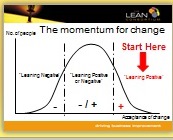By Andrew Nicholson, Managing Director of Nicholson Consultancy Ltd
With British politics moving away from three main parties and fragmenting into much wider choice, the prediction is that this week’s election will end up with another coalition Government.
However, politics and governing a country are not the only arenas where a coalition framework can be adopted – Lean Manufacturing needs a ‘Guiding Coalition’ to succeed.
This is because the hardest aspect of creating a truly Lean organisation is creating the right culture – a positive “can do” approach that challenges accepted norms and continuously seeks a better way.
And the hardest step is always the first.
That’s why it’s essential to start working with the right people.
At the most senior level, top management must be committed to making Lean happen – there needs to be a critical mass; what Dr John Kotter calls the “Guiding Coalition”.
Once we have that commitment, we need to understand how people will react to change, and we need to know how we should manage them.
In any group of people faced with significant change, we can expect a whole range of responses. If we drew these on a graph, they’d often follow what statisticians call a “normal distribution”; more commonly described as a “bell curve” or 2:6:2 curve, as shown in the diagram.
At the negative end of the curve we have a small number of people – typically 20% of the total – who actively oppose change. They’re sometimes referred to as the CAVE-dwellers: Completely Against Virtually Everything.
And keeping to the election analogy, in the middle we have the bulk of people, perhaps 60% – the “floating voters” who can be swayed in either a positive or a negative direction.
And over at the positive end of the spectrum we have another small group – typically 20% of the total – who are positive about change and at least prepared to give it a go.
Here’s the key point that many managers don’t understand: if you want to make change happen, work with the willing – the positive 10%.
These people are the Change Agents – at The Lean Consortium we call them the Lean Leaders – and they’re absolutely crucial to the success of Lean in any organisation.
These are the people that we work with to start the ball rolling, and get some “quick wins”. And this is what they look like:
• Keen to make a difference
• Accepts the need for change
• Eager to learn / seeks development opportunities
• Respected by peers and management
• Influential, with good people skills
• Able to overcome resistance and get things done
At the same time, it’s vital that you avoid getting bogged down with the CAVE-dwellers at the other end of the spectrum – these “energy vampires” can suck out every last ounce of positivity if you let them.
By all means listen to what they say – they just might have some good ideas – but don’t spend too much time with them, and don’t waste time trying to convert them to the cause. Your time is much better spent with the other folk.
By working with the willing you’ll find that life is a lot easier: you’ll get some “Quick Wins”, the “floating voters” will begin to get on board and you’ll build up the momentum that you need to sustain continuous improvement across the organisation.



